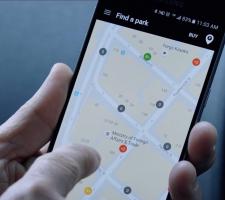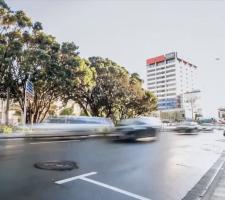
A smart parking solution can ease pain for drivers and increase efficiency for local authorities - and New Zealand’s capital is feeling the benefit. Adam Hill reports.
ITS technology has the power to ease headaches for local authorities and car drivers alike when it comes to parking. For urban dwellers, few things are more irritating than driving slowly around crowded city centre streets, anxiously searching for a parking space – indeed, in congested downtown areas, as much as 30% of traffic can be driving around looking for parking spaces.
Having finally secured a spot – close enough to the shops to mean that you will not get a hernia lugging your purchases back to the car - you are then faced with another issue: how to pay. Many meters will only take the correct money. A sense of helpless irritation will be familiar to anyone who has wanted to stop for 15 minutes but is forced to pay for an hour’s parking – or who does not have small change and ends up having to pay for two hours’ parking rather than one. Drivers are not the only ones to find this annoying: local shop owners often complain that draconian or user-unfriendly parking systems have scared customers away. Fairness and efficiency are often in short supply.
Laborious and inefficient
Not only that: once you have a ticket, there is the chore of putting it inside the windscreen – and even having to dash back to the car from wherever you are to replace it – if you need more time. For councils, managing this sort of arrangement means employing parking control officers who are tasked with visually identifying overstays – risking the anger of irate drivers who do not want a parking infringement notice, and inevitably missing some malefactors in what is a laborious and inefficient process.
For everyone concerned this is stressful, annoying – and, in this day and age, surely a little outdated?
Wellington City Council certainly thinks so. New Zealand’s centre of government and the world’s southernmost capital city has a population of around 496,000.
The central business district (CBD) of the pretty capital of New Zealand is popular with visitors, given its proximity to the city’s parliament buildings, beaches and harbour. The council has given its drivers a break by introducing ‘pay by space’ technology which means you pay for your length of stay in the parking bay – and not a minute more – and get practical help finding bays which are empty.
Pay and walk away
Greg Orchard, chief operating officer of Wellington City Council, explains: “The idea is that within our city centre people will be able to come in, they’ll be able to find a car park using an app on their phone or smart device, and they’ll be able to park in that space, pay for that park, and in effect just walk away.”
Technology company
Smart Parking had just installed 3,000 sensors in London’s Westminster district. Wellington’s authorities were enthused about the possibilities, meaning that Smart Parking was pushing at an open door. “The council had a clear view on what they wanted as they had already tested the market with trials from a number of in-ground sensor vendors,” Gillespie says.
Reducing emissions
The solution which Wellington has gone for uses infrared sensors which register whether each parking bay is occupied or empty, in conjunction with a smartphone app called PayMyPark, which provides real-time parking availability information and enables users to pay. Trialled in early 2015, it went live in August 2016. It should save drivers time, while reducing emissions from cars aimlessly pootling round, block after block, hoping for a space.
“[The council] had no real accurate visibility as to what was going on on their streets,” says Larry Eade, head of operations, Asia Pacific for Smart Parking. “With the introduction of a sensor technology solution, you can have that accurate, real-time data telling you exactly what’s happening in those streets: what time of the day people are coming, how long they’re staying, and all the information that helps planning strategy for the long-term vision of the city.”
Information from the sensors is fed instantly to PayMyPark, which can guide drivers to free spaces and lets them pay from their phone – and, crucially, to extend their time too. The data is relayed live to SmartRep, Smart Parking’s cloud-based software tool, allowing the council to see how drivers are using the city’s spaces and giving them information to make adjustments to the parking systems accordingly.
Real-time information
“We provide the same real-time information to the council’s parking patrol officers, who can view the information on their hand-held device,” says Gillespie. “This allows them to see who has paid and how long cars have been parked, et cetera.”
“I think what it will allow us to do is to get better information around the demands for on-street space, whether that’s for public transport, for parking or for pedestrians, and by getting that information through the sensors we’ll be able to manage that demand,” Orchard says.
The key advantage is a true picture of what’s happening on the streets in real time, Gillespie insists. “We provide incredibly rich data that allows local government departments to truly understand their business. Real-time data allows you to make decisions on pricing, cost management and kerbside staff management. Also, real-time information sent to the public via a smart phone allows people to make decisions on where they park before they arrive. This means that congestion is eased, C02 emissions drop and the parking experience has been transformed from something that used to be painful to something that is easy.”
Future-proofing
Smart Parking suggests that its sensors have been future-proofed by making them radio-frequency identification (RFID)-capable. The benefits of this include, for example, being able to put RFID-enabled permits in disabled people’s cars to let authorities know there is a disabled vehicle parked in a mobility space, Eade says. “When you’ve got real-time data coming out of those sensors over a period of time, you can tell exactly what’s going on in that street, and that’s of massive benefit to the ratepayers, the retailers and everybody else.”So not only should Wellington’s drivers be able to find a space more quickly – but they will also just be paying for what they use.
How does it work?
An infrared beam from the sensor is picked up by wireless technology, which sends it to Smart Parking’s SmartSpot communications device. It is then sent via 3G or Wi-Fi into the cloud and then into servers where it can be accessed.
Drivers input the parking bay number into the PayMyPark app and press ‘start’ to begin their parking time. Returning to the vehicle they press the ‘stop’ function – thus only paying for the time they use. The sensors automatically detect when a car arrives and relay the information to PayMyPark, alerting the application of the car’s arrival and departure.
Drivers can choose to pay in advance – and should they come back to their vehicle before their parking time has expired, their account will be refunded the remaining minutes. The app also generates customer alerts to let people know that time is running out, and allows the user to top up their parking session remotely – without the hassle of having to return, buy another ticket and place it in the car. “If you go away from your car parking space and you need to stay for longer, you can top up on your phone,” says Orchard.













